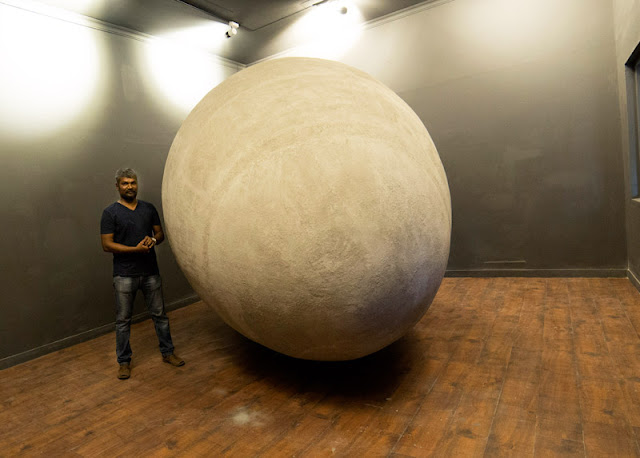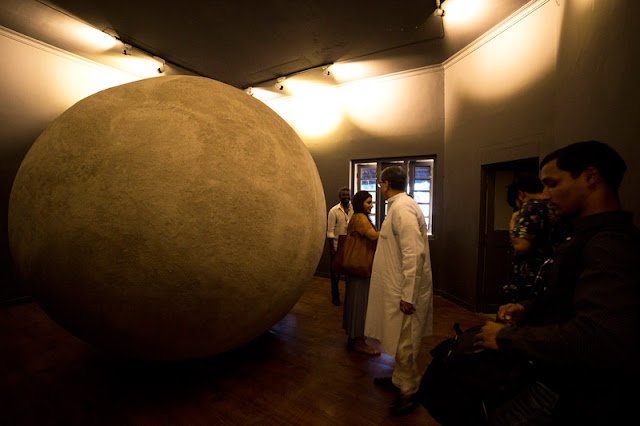 |
| G R Iranna's installation ‘GARBH’ at KMB 2016 in Aspinwall House,Fort Kochi |
In its narrow room inside Aspinwall House, a giant egg occupies its space so wholly that it seemingly leaves little room for observers to doubt its intent, or even move about for that matter. And yet, the sculpture – aptly named ‘Garbh’ – is pregnant with meaning.
Composed of vibhuti (holy ash) coated over a metal support frame, the egg – created by Kochi-Muziris Biennale (KMB) 2016 participating artist G.R. Iranna – is not merely an allusion to the cycle of life and death. It ponders also whether there could be life after, or even from, death.
“My intention was to make form from the formless,” said Iranna, a Delhi-based artist whose works often make a comment on the violence and aggression of life. In Garbh, he prompts viewers to engage with such ideas as life being a mirror to death or remembering life in death.
Taking his cue from the importance accorded to ash in scripture, Iranna looks at how life takes form out of the void and returns to it in death. He used ash collected from Varanasi and other places to create the installation, which weighs around 1,200 kg and has some five or six layers.
Vibhuti, to which several meanings and purposes are attributed in Hinduism, is made from burnt dried wood in Agamic rituals. It is traditionally applied by adherents as three horizontal lines across the forehead and other parts of the body.
“Ash is a material I’ve always been fascinated with. It is the product after purification through fire, the remains of the dead,” said Iranna, who used the vibhuti – the last remnants of a no-longer existent body, “something close to nothingness”, to create the shelled womb. “The work can have multi-layered perspectives depending on how much time you spend with it,” he said.
 |
| G R Iranna's installation ‘GARBH’ at KMB 2016 in Aspinwall House,Fort Kochi |
Visitors have offered a range of perspectives such as whether the sculpture is a comment on the cosmic dimension of infinity, the loop from form to formless, among others. In filling up the height and length of the room, the expansive multimedia installation is also a subtle metaphor for the spaces and shapes of debate and dialogue between opposing ‘truths’.
“We worked on Garbh in Delhi for around one month and took about 12 days to re-assemble and put the final touches to it at Aspinwall House,” Iranna said. “Since the art work couldn’t pass through the door to the room where it was to be exhibited, we dismantled the metal structure, reassembled it inside and carried out the layering process again,” he said.
‘Garbh’ is in keeping with a running theme in Iranna’s long-spanning art practice: exploring the constraints of time and space and the freedom upon the absence of either – a philosophy based on existential crises and narratives in a metaphysical dimension.
“I am more interested in eastern philosophy: of an understanding starting from the self,” said the Karnataka-born artist who has won many awards including the National Award from Lalit Kala Academy in 1997 and the AIFACS award at the show ’50 years of art in independent India’.
Comments
Post a Comment